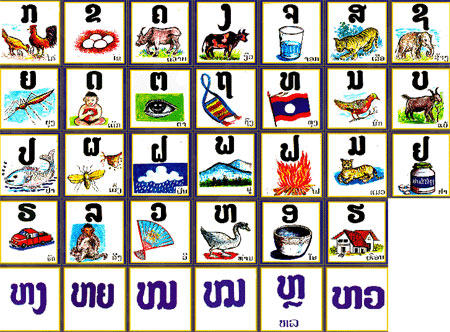New falang hit the tarmac at Wattay clutching their Lao for Beginners books, chock-full of promises and enthusiasm to learn this exotic new language. Experienced falang relish the opportunity to share their wisdom and recommendations regarding “Lao tutors” to wide-eyed new arrivals, while carefully omitting the fact that they haven’t actually studied for months. New falang eagerly attend their first lessons and feel proud of their ability to ask for prices in Lao (despite not always understanding the replies), and looking forward to the day when they will be chatting away with wizened old matrons at baci ceremonies and then blogging about it later.
Lao lessons are an essential ingredient of the falang introduction to life in Laos, serving as the initial attempt to get in tune with local customs. Inevitably, it’s not long before the enthusiasm wanes, and the falang is musing about “getting back into” studying Lao one day when they are not so ‘busy’. Given their calendar of hobbies and social events, falang simply “don’t have enough time” to learn Lao properly.
Paradoxically, although falang never advance very far in Lao, they can often be heard saying that Lao “really isn’t that difficult” compared to English. Don’t point out the fact that if the grammar is really that easy, they should surely be conversational by now. Falang will generally get defensive and disgruntled, and mumble something about tones.
Falang speakers of Lao can be generally divided into three levels:
- The Non-Lao Speaker (aka. The “Check Bin” Falang): This falang makes little to no effort to learn the language and covers up their embarrassment with defiance (“It’s not useful outside this country”). They generally know a handful of key words such as sabaidee, khop jai, and numbers.
- The Average Falang (aka. The “Bor Khao Jai” Falang): Nearly all falang in Laos fall into this category. Average Falang Lao speakers are limited to “market Lao.” They can be heard at Talat Sao haltingly saying “thao dai” and “ngarm laiy” and have a limited vocabulary of food and color words that they mispronounce often enough to be understood 50% of the time.
- The Conversant Falang (aka. The “Khoi Vao Pasa Lao Dai” Falang): These falang speak well enough to make them a very useful person to have around, if you are a non-Lao speaker. They generally emanate an air of superiority to other falang. In rare cases, the conversant falang can also read and write Lao, and this variety are likely insufferable and should be avoided, as they will find as many opportunities as possible to “subtly” brag about their literacy. When inferior falang use Lao, the Conversant Falang will sometimes pretend not to understand at first, and then “translate” what they are saying into more correct Lao to any Lao people around who are still bothering to listen.
If you are a Lao person trying to speak with falang, carefully gauge their language level to determine just how much Lao you can vao. All falang live for the day when they hear “vao pasaa lao geng geng” from a street vendor. They always leave interactions like this basking in the glow of their authentic cultural experience.
